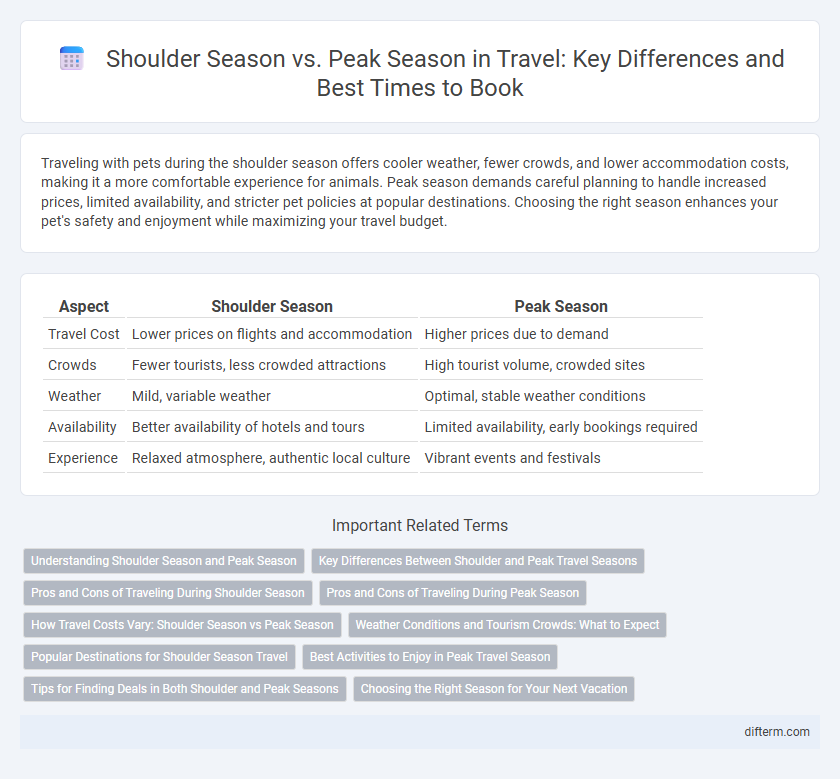Traveling with pets during the shoulder season offers cooler weather, fewer crowds, and lower accommodation costs, making it a more comfortable experience for animals. Peak season demands careful planning to handle increased prices, limited availability, and stricter pet policies at popular destinations. Choosing the right season enhances your pet's safety and enjoyment while maximizing your travel budget.
Table of Comparison
| Aspect | Shoulder Season | Peak Season |
|---|---|---|
| Travel Cost | Lower prices on flights and accommodation | Higher prices due to demand |
| Crowds | Fewer tourists, less crowded attractions | High tourist volume, crowded sites |
| Weather | Mild, variable weather | Optimal, stable weather conditions |
| Availability | Better availability of hotels and tours | Limited availability, early bookings required |
| Experience | Relaxed atmosphere, authentic local culture | Vibrant events and festivals |
Understanding Shoulder Season and Peak Season
Travelers benefit from understanding shoulder season, which occurs just before or after peak season, offering fewer crowds and lower prices. Peak season is characterized by high demand, increased prices, and busy tourist attractions, often corresponding with favorable weather conditions or holidays. Choosing shoulder season travel can provide a balance between pleasant weather and cost-effectiveness, while peak season ensures access to all major events and amenities.
Key Differences Between Shoulder and Peak Travel Seasons
Shoulder season offers moderate weather, fewer crowds, and lower prices compared to the peak travel season, which features popular destinations at their busiest with higher accommodation costs and full activity schedules. Travelers benefit from better availability and more authentic local experiences during the shoulder season, while peak season guarantees optimal weather and a vibrant atmosphere. Understanding these differences helps optimize trip planning for budget, comfort, and adventure preferences.
Pros and Cons of Traveling During Shoulder Season
Traveling during the shoulder season offers fewer crowds and lower prices on accommodations and flights compared to the peak season, enhancing the overall travel experience. Destinations like Europe in spring or fall showcase pleasant weather and accessible attractions, but some services and businesses may have limited hours or closures. This period balances cost savings and comfort but requires flexibility and research to maximize the benefits of less congested popular tourist spots.
Pros and Cons of Traveling During Peak Season
Traveling during peak season offers the advantage of vibrant local events, optimal weather conditions, and fully operational tourist attractions, ensuring a lively and engaging experience. However, peak season often entails higher prices for accommodation and flights, along with crowded destinations that can diminish personal comfort and increase wait times. Prioritizing early bookings and flexible itineraries can help travelers maximize the benefits and mitigate the drawbacks of peak season travel.
How Travel Costs Vary: Shoulder Season vs Peak Season
Travel costs during the shoulder season are significantly lower than in the peak season, with accommodations often slashed by 20-50% and airfare prices more competitive due to decreased demand. Peak season prices surge as popular destinations experience high occupancy rates, driving up hotel stays, tours, and local attractions fees. Budget-conscious travelers benefit from the shoulder season's cost savings, while peak season offers premium service and availability at a premium price.
Weather Conditions and Tourism Crowds: What to Expect
Shoulder season offers mild weather conditions with fewer tourism crowds, providing a more relaxed and enjoyable travel experience. Peak season features warmer temperatures and vibrant atmospheres but comes with heavy crowds and higher prices. Travelers seeking a balance between pleasant weather and manageable visitor numbers often prefer shoulder season destinations.
Popular Destinations for Shoulder Season Travel
Popular destinations for shoulder season travel include Mediterranean cities like Barcelona and Rome, where milder weather and fewer tourists enhance the experience. Coastal regions such as the Amalfi Coast and Greek Islands offer pleasant temperatures and reduced crowding compared to peak summer months. National parks like Zion and Yellowstone attract visitors during early spring or late fall, providing comfortable hiking conditions and more available accommodations.
Best Activities to Enjoy in Peak Travel Season
Peak travel season offers vibrant festivals, bustling local markets, and popular beach destinations ideal for sunbathing and water sports. Tourists can experience guided city tours, outdoor concerts, and hiking in national parks with optimal weather conditions. Booking accommodations and attractions early ensures access to the most sought-after experiences during this high-demand period.
Tips for Finding Deals in Both Shoulder and Peak Seasons
Travelers can secure better deals in the shoulder season by targeting mid-week stays and booking accommodations early when prices tend to drop between high and low demand periods. During peak season, flexibility with travel dates and considering less popular destinations within a region can lead to significant savings despite overall higher costs. Utilizing price comparison tools and signing up for fare alerts ensures timely access to discounts and special offers across both shoulder and peak seasons.
Choosing the Right Season for Your Next Vacation
Selecting the ideal travel season depends on balancing cost, crowd levels, and weather preferences. Shoulder season offers lower prices, fewer tourists, and mild weather, making it perfect for budget-conscious travelers seeking a more relaxed experience. Peak season provides vibrant activities and guaranteed sunshine but comes with higher costs and crowded destinations.
Shoulder Season vs Peak Season Infographic

 difterm.com
difterm.com